Mosquito problem? Add these gorgeous carnivorous plants to your garden
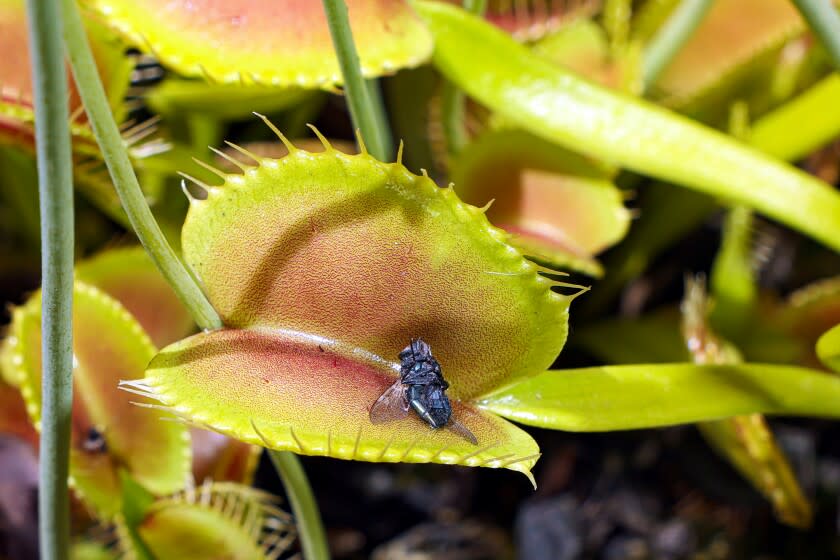
They call themselves Skippy, a strangely cheerful name for a group devoted to a fairly creepy endeavor (at least from this animal's perspective) — the care and breeding of carnivorous plants.
Yes, we're talking about plants that prey on living creatures — insects mostly, but in some far-off jungles even small mammals and birds. (In Borneo, one pitcher plant — Nepenthes rajah — has even evolved to sup on the droppings of shrews.)
It's a little gruesome, "but that's exactly why people love them so well," said John Kim, president and co-founder of SCCPE (a.k.a. Skippy) — the Southern California Carnivorous Plant Enthusiasts, which is having its second-ever show and sale June 18-19 at Sherman Library & Gardens, 2647 E. Coast Highway, Corona del Mar, from 10:30 a.m. to 4 p.m. each day. The show is free with $5 admission to the gardens (members and children 3 and younger enter free).
"Half the people will tell you they love the carnivory — turning the table on nature to where the plants eat the bugs — but others will tell you they love the variety," Kim said. "The general public thinks of Venus flytraps, but that's just a small percentage of the carnivorous plants that can be found on every continent except the Arctics."
To call carnivorous plants exotic is an understatement — they grow in extraordinary shapes and colors, with the common thread being they all have an area big enough to hold and digest their prey, whether it's inside the slippery, tube-shaped bodies of North American pitcher plants or the flat sticky leaves of the succulent-like butterwort.
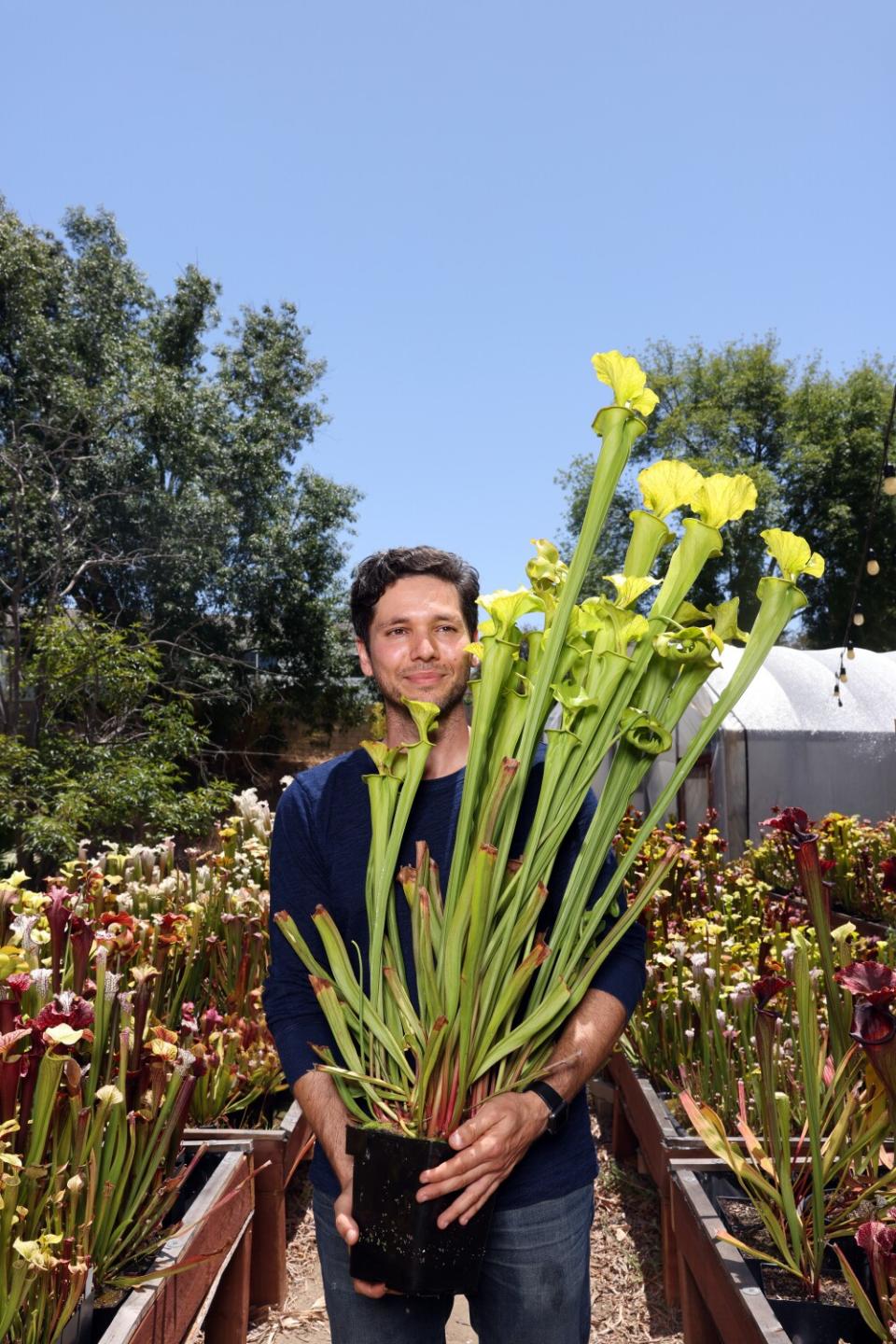
Most plants get their nourishment from the sun and soil, but carnivorous plants have evolved to digest animals, usually hapless bugs fatally attracted to the plants' sweet, sticky nectar and other deadly wiles, like soft downward pointing hairs that make gliding down the fragrant throat of a pitcher plant a piece of cake (or fly) but climbing out impossible.
David Fefferman, a Skippy member from Mission Viejo and one of California's largest collectors and breeders of carnivorous plants, agrees that the carnivory is what initially attracts many fans. "But nobody really dwells on the death aspect of it. 'Carnivorous plant' is definitely the headline, but once you get involved, you stay for the joy of growing fascinating, beautiful plants."
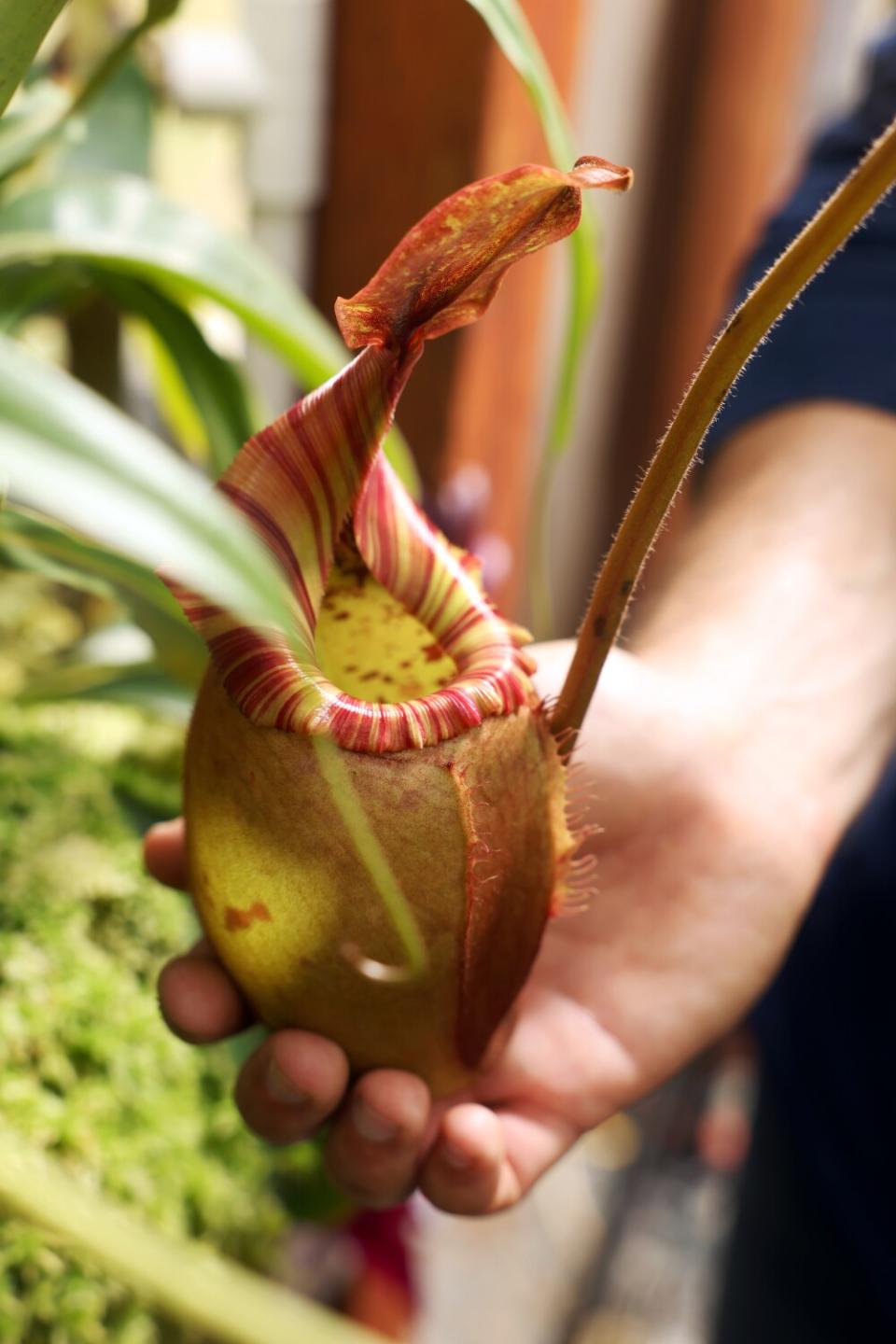
But it's not just that these plants are unusual, Kim said. "They are functional as well. They don't eat meat exactly. They eat flies, gnats, fruit flies, spiders and mosquitos, so really they're your friends. Orchid growers will always keep a few around because, with all the wetness and humidity their plants like, they always struggle with pests."
His pitcher plants are so effective at catching insects, Kim said, "They sometimes overflow at the top! And because North American pitcher plants go dormant in the winter, they kind of fall apart, so all the bugs' exoskeletons are exposed, where they break down in the soil or just blow away in the wind. Because the plants can't digest the exoskeletons; they only digest the soft parts of the insects."
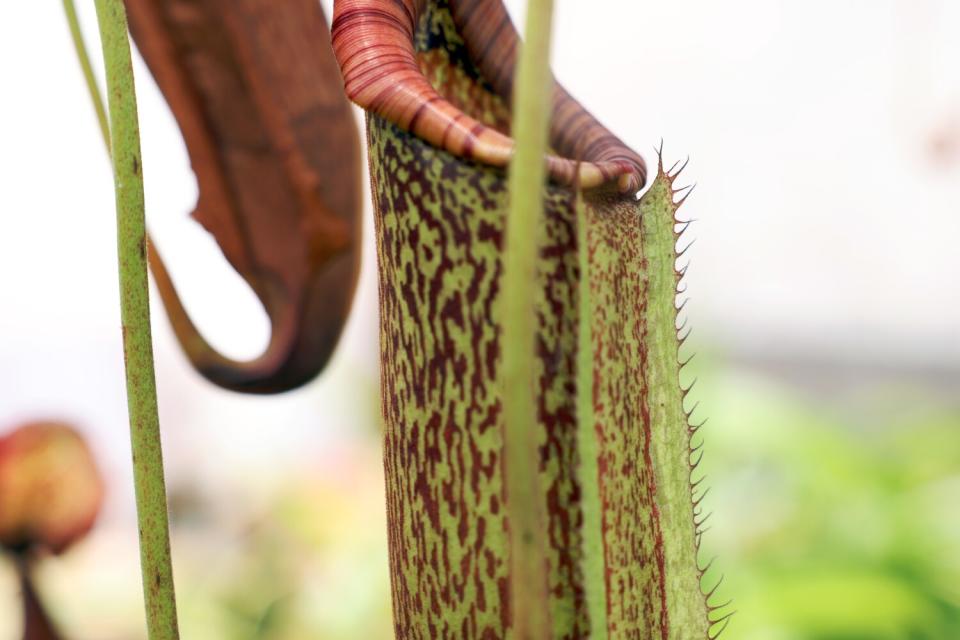
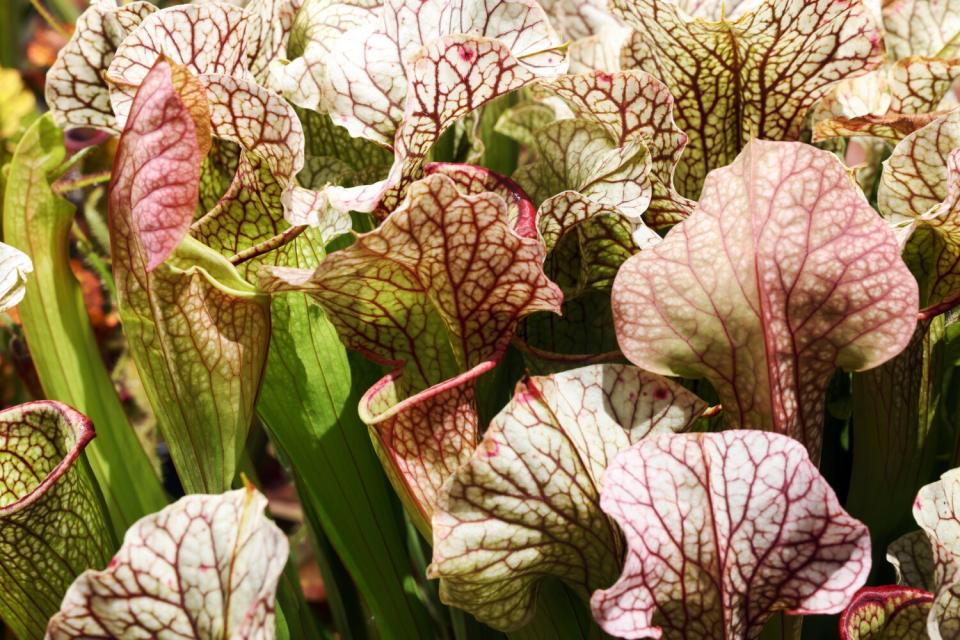
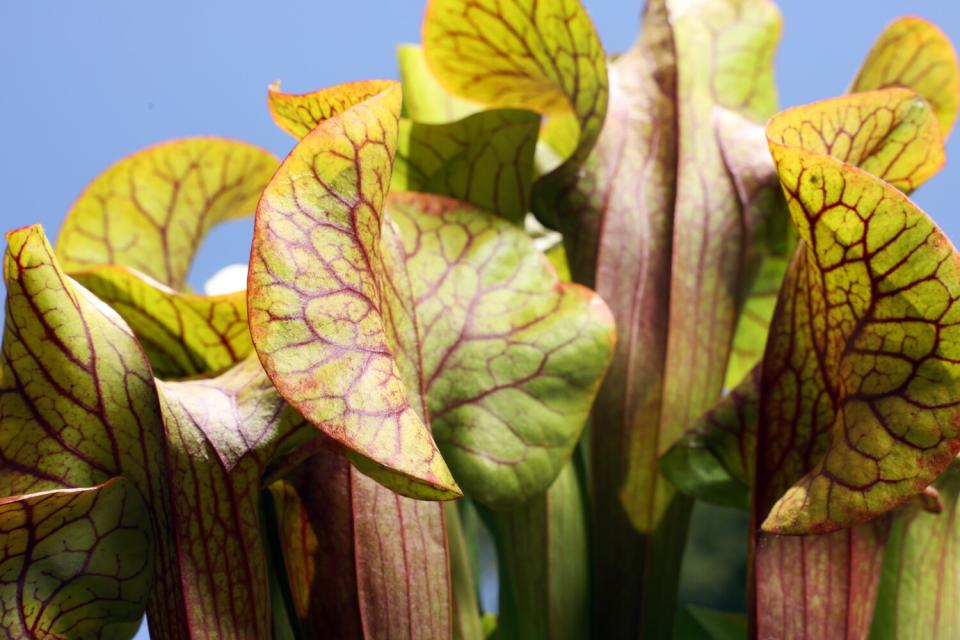
In case you want a more graphic image of this, Kim said the club will be displaying various carnivorous plants cut open so you can see their buggy digestive systems.
Ewwww.
Just to be clear, Kim is not a teenager. He's married, about to turn 39, and works 60 to 80 hours a week as a construction project manager in Orange County. He has many hobbies, including other plants, and loves joining clubs that cater to his interests. "It's where I find enjoyment. I don't watch TV, read books, drink or gamble. My 'me' time is being involved with these clubs. I do meeting minutes for fun, I love to listen to lectures, and I have five different copies of 'Robert's Rules of Order.' ... I guess the world needs people like me too."
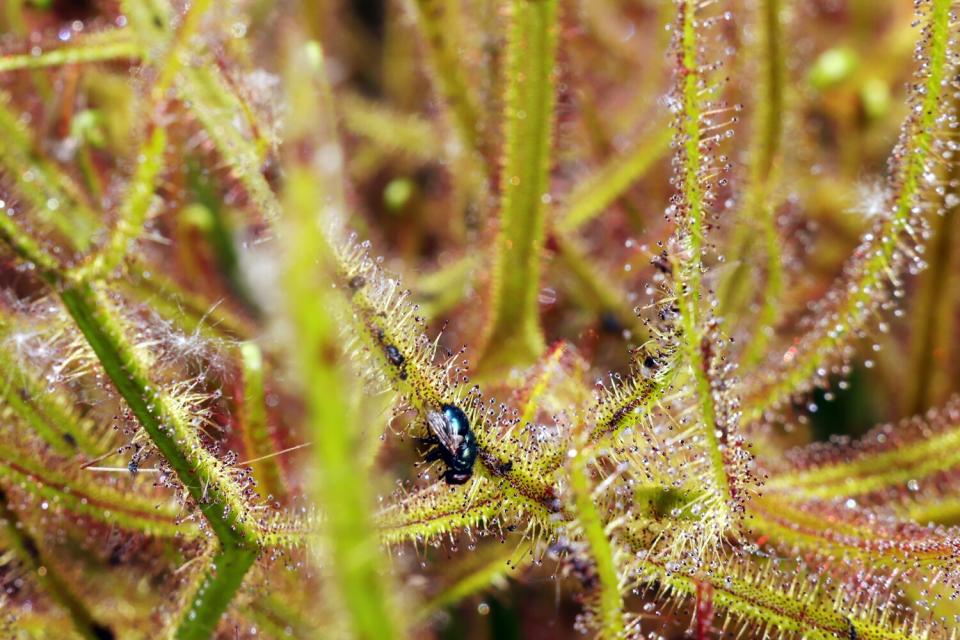

His carnivorous plants play big roles in his other passions. He's adopted a parrot and tortoises, whose droppings draw flies to his yard — and those flies are efficiently consumed by his useful pitcher plants.
Although they look very exotic and temperamental, most carnivorous plants are pretty easy to grow, Kim and Fefferman agreed. Some are happy in a windowsill with bright, indirect light. Others, like the North American pitcher plant, are from the country's steamy, boggy parts of the southeast, so they prefer to be outdoors in Southern California where they can drink up all our heat.
But you can't put them in the ground, Fefferman said. He plants his in pots filled with a 60/40 mix of peat moss and perlite because regular potting soil or even regular soil would be too rich and burn the roots. And he keeps a saucer filled with an inch or two of water under all his pots. Most plants will drown if their roots stay too long in water, but pitcher plants evolved in marshes leached of nutrients, said Fefferman, which is why they turned to insects for nourishment.
And because carnivorous plants evolved in depleted soils, they are very sensitive to minerals or fertilizers in their water too, Fefferman said. Our drinking water is full of minerals, so he uses rainwater (when available) or a reverse osmosis system to demineralize his water (the kind found in many under-sink filtration systems). Kim said you can accomplish the same thing by using distilled water, available at drugstores.
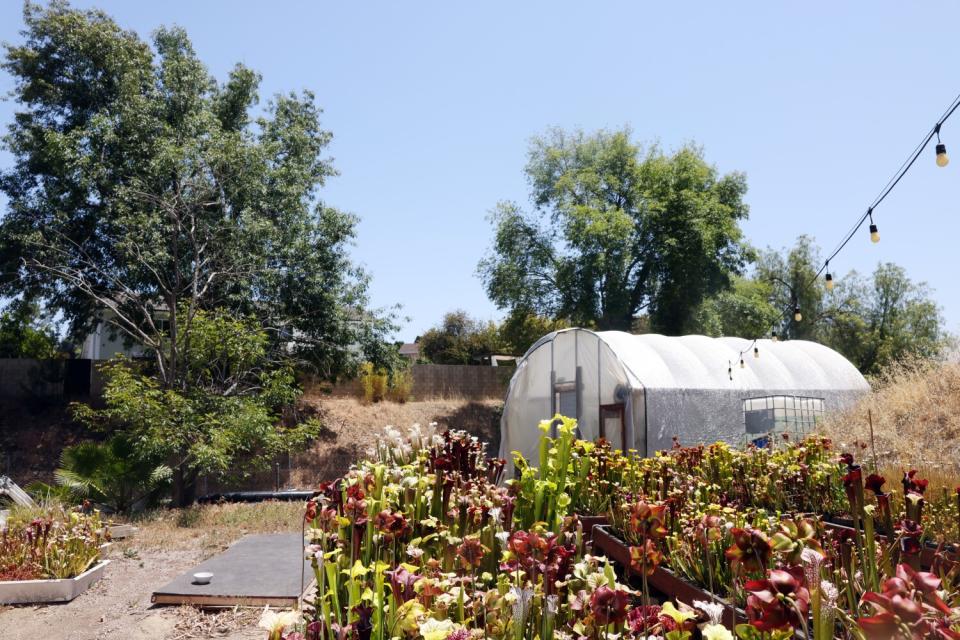
Skippy is a relatively new Orange County-based club — its first meeting was two weeks before the COVID-19 shutdowns in March 2020 — but club members used Zoom to hold monthly meetings during the pandemic and now there are about 100 members. They're eagerly preparing for their second show and sale on Father's Day weekend.
If the turnout this year is anything like the first year — which drew more than 1,300 people over two days — you'd better come early and expect a very diverse crowd, said Kim.
"Throughout the weekend we had [Sherman] garden staff telling us they'd never seen so many young people in the garden," Kim said.
"We had conservatives and goths, just a plethora of people coming to the garden, and it was very noticeable."
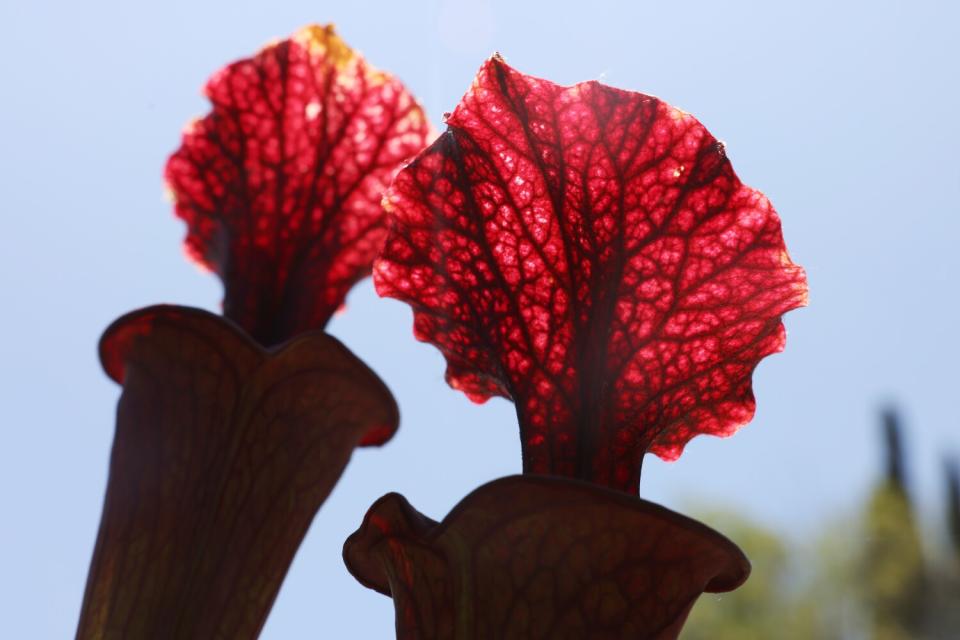
Fefferman, a product manager for the tech company Linktree, won some top prizes last year, and he's excited to show again. He'll also be among the vendors selling some of his thousands of plants. At some point, Fefferman said he'll have to consider becoming a nursery, but for now, he just maintains his website, a marketplace for other carnivorous plant vendors called CarnivorousPlantResource.com, where prices range from $5 for seeds to more than $1,000 for rarer plants.
He expects beginners to find a good selection at the show, with prices around $30. And he really wants to emphasize that these plants are spectacular despite their carnivorous ways.
"I don't like these plants because they kill things," Fefferman said. "In fact, I'm very much about them not killing things. If I see a honeybee in one, I will fish it out, because bees have enough troubles already. But I love the natural world, and these plants lean into that, because they're super fascinating and super beautiful."
If bug-eating plants don't ring your bell, there are lots of other plant- and garden-related events and activities for June. Email events to jeanette.marantos@latimes.com at least three weeks before they happen, and we might include them in the calendar.
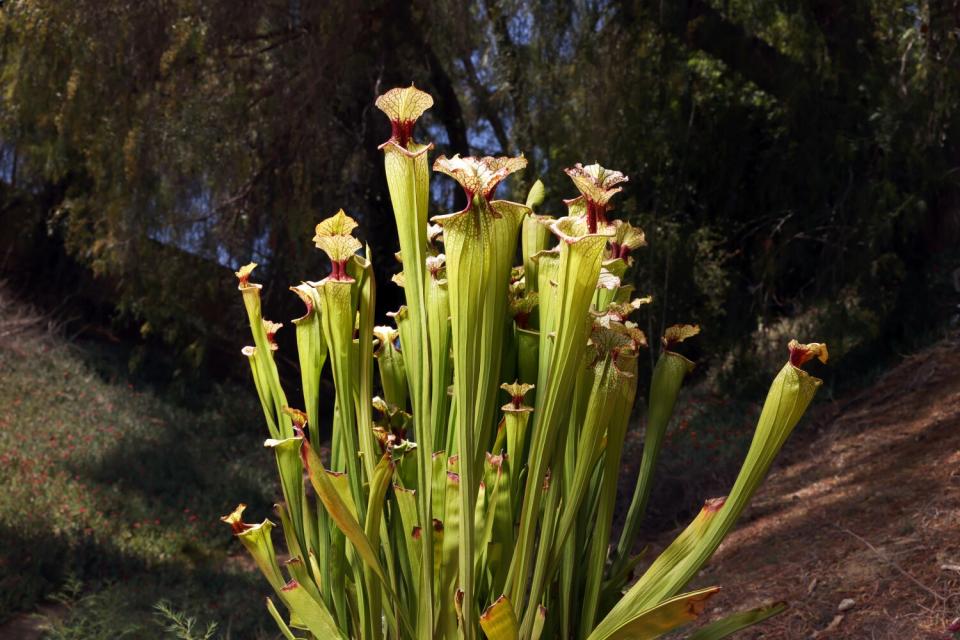
More June gardening events in SoCal
June 3-4
Spring Plant Sale at the Fullerton Arboretum, 1900 Associated Road, Fullerton, features more than 100 California native and ornamental plants grown at the arboretum, along with pots of herbs. The sale is limited to arboretum members and Titan Club cardholders on June 3 from 2 to 5 p.m. The sale on June 4 is open to the public from 9 a.m. to 3 p.m. Members get a 10% discount on all plant purchases. fullertonarboretum.org
June 4
Plumeria A-Z, a hands-on workshop about plumeria care, seeds, genetics, grafting and common problems, taught by Diana Donnellan from 10 a.m. to 1 p.m. at the Los Angeles County Arboretum & Botanic Garden, 301 N. Baldwin Ave., Arcadia. Participants should arrive by 9:30 a.m. Tickets are $40 ($30 for members). arboretum.org
Wildfire Resilience, a free, daylong event of classes and information at the Theodore Payne Foundation, 10459 Tuxford St., Sun Valley, includes a talk by botanist Terry Huang about the botany of fire and how wildfire affects native plants, and a Wildlife Community Preparedness class taught by Kat High, a native Californian of Hupa descent, a native plant gardener in Topanga Canyon and a participant in the Topanga Coalition for Emergency Preparedness Neighborhood Network for Zone 7. A wildfire literature, discussion and activity table will be available at noon. eventbrite.com
June 4-5
The Southern California Hemerocallis & Amaryllis Society Daylily Show & Plant Sale from 9 a.m,. to 4 p.m., both days at Ayres Hall in the Los Angeles County Arboretum & Botanic Garden, 301 N. Baldwin Ave., Arcadia. Daylily bulbs will be available for purchase. Admission is free with $15 entry to the gardens ($11 seniors age 62+ and students with ID, $5 children 5 to12, free to members and children 4 and younger.) arboretum.org
June 5
Windsor Square-Hancock Park Historical Society Garden Tour includes five gardens in the historic neighborhoods of Windsor Square, Hancock Park and Brookside, including drought-tolerant plantings and a home and backyard built over the Brookside Stream. The tour includes refreshments, a plant sale and a silent auction for items from local homes. Tickets are $50 ($40 for historical society members) and can be purchased the day of the event, at 166 S. Plymouth Blvd., Windsor Square, or online. windsorsquarehancockpark.com
June 9
California Native Container Plants, a class about how to grow native plants in pots taught by Theodore Payne Foundation nursery sales manager Flora Ito, from 9 to 10 a.m. at the nursery, 10459 Tuxford St., Sun Valley. The class is $25 ($20 for members). Register online. eventbrite.com
June 11
Creating Living Soil is a class taught by Michael Wittman of Blue Sky Biochar about how to create and maintain a living soil by using biochar, a type of charcoal made from bamboo that provides a structure for accelerating microbial activity in your soil. The class is from 11 a.m. to noon at Fig Earth Supply, 3577 N. Figueroa St., Mt. Washington. Register online, $8 (with processing fees). figearthsupply.com
June 11-12
Los Angeles International Fern Society Fern and Exotic Plant Show & Sale, 9 a.m. to 4:30 p.m. each day at the Los Angeles County Arboretum & Botanic Garden, 301 N. Baldwin Ave., Arcadia. Free workshops and talks each day, including basic fern care at 11 a.m. on June 11 and 1:30 p.m. on June 12, and mounting staghorn ferns at 1:30 p.m. on June 11 and 11 a.m. on June 12. The plant sale will include many varieties of ferns, begonias, carnivorous plants, bromeliads, orchids and other exotic plants, as well as growing supplies. Admission is free with $15 entry to the gardens ($11 seniors age 62+ and students with ID, $5 children 5 to 12, free to members and children 4 and younger). laifs.org
June 9-12
Tonalism (in Space) at Descanso Gardens, a four-day quadraphonic sound exploration by dublab that features meditative music and sound baths in different sections of the garden from 10 a.m. to 5 p.m. June 9-10, and 10 a.m. to 4 p.m. June 11-12, at 1418 Descanso Drive, La Cañada Flintridge. Admission is free with $15 entry to the gardens ($11 seniors 65+ and students with ID, $5 children 5 to 12, free for members and children under 5). A special Tonalism: Night event on June 11 features ambient music inspired by La Monte Young's "Dream House," as well as the work of Terry Riley, John Cage and Yoko Ono, from 6 p.m.. to 1 a.m. Tickets are $25 ($20 for members) and can be purchased online. descansogardens.org
June 12
Theodore Payne Foundation's Pollination Party, 1 to 5 p.m. at Eagle Rock Brewery, 3056 Roswell St., Suite A, in Glassell Park, will feature the third run of Local Source beer, a lager infused with black sage, woolly bluecurls and California bay laurel, along with native-plant-flavored pizza by a Quarantine Pizza pop-up and ice cream by a Sad Girl Creamery pop-up. Theodore Payne will be selling pollinator-friendly native plants at the event, including narrow- leaf milkweed, as well as other merchandise. Admission is free. eventbrite.com
June 18
Organic pest control for your garden, a class taught by Conor Fitzpatrick, owner of Fig Earth Supply nursery, about how to identify, control and prevent pests in your organic vegetable garden, from 11 a.m. to noon at Fig Earth Supply, 3577 N. Figueroa St., Mount Washington. Register online, $8 (with processing fees). figearthsupply.com
Sunrise Monarch Count Training, a free training session with Richard Rachman, the Los Angeles County volunteer coordinator for the western monarch count around Thanksgiving and New Year's Day in cooperation with the Xerces Society for Invertebrate Research. Rachman is conducting a mock training at 6 a.m. at Tongva Park, 1615 Ocean Ave., Santa Monica, to mimic the actual time volunteers will be expected to turn out to count the endangered monarch butterflies at their overwintering sites during the late fall and winter. Participants are encouraged to bring binoculars and a cellphone, and will be trained on protocols, general ideas and tips for monitoring migratory monarchs to prepare for a coming season. Register online. eventbrite.com
June 18-19
Culver City Garden Club 68th Show & Sale includes morning and afternoon workshops, vendors selling garden items, a judged exhibition of homegrown plants in more than 100 categories from flowers to vegetables and a plant sale by club members at the Culver City Teen Center, 4153 Overland Ave., near Culver Boulevard and the swimming pool, from 11 a.m. to 4 p.m. on June 18, and 10 a.m. to 4 p.m. on June 19. Admission is free. culvercitygardenclub.org
June 21
Summer evening stroll through the Fullerton Arboretum, from 6:30 to 8:30 p.m. at 1900 Associated Road, Fullerton, features free refreshments and live music by students from the California State University, Fullerton School of Music. Members enter free with advance reservations; nonmembers can buy $10 tickets at the gate. fullertonarboretum.org
June 22-24
Music in the Gardens @ Descanso Gardens, from 11 to 11:45 a.m. and 1 to 1:45 p.m. each day, featuring performances by Le Ballet Dembaya, a West African drum and dance ensemble on June 22, Tres Souls, a bolero-style trio reliving the songs of the 1940s-1960s golden era of Mexican cinema on June 23, and Quarteto Nuevo, a musical ensemble that merges Western, classical, Eastern European folk, Latin and jazz, on June 24. Admission is free with $15 entry to the gardens ($11 seniors 65+ and students with ID, $5 children 5 to 12, free for members and children under 5). descansogardens.org
June 25
Summer Camp for Adults: Bawdy Botany from noon to 4 p.m. at the Los Angeles County Arboretum & Botanic Garden, 301 N. Baldwin Ave., Arcadia. "Come discover the fascinating botany of love and lust," according to the website, such as the botanical origins of the birth control pill, plants considered aphrodisiacs throughout history and the bizarre secrets of ficus sex. Participants must be 21 to register. The class is $49. arboretum.org
June 27
South Coast Orchid Society of Long Beach's monthly meeting features guest speaker Carol Beule, costume designer, orchid grower and judge, at 7 p.m. at the Whaley Park Community Center, 5620 E. Atherton St., Long Beach. southcoastorchidsociety.com
This story originally appeared in Los Angeles Times.

